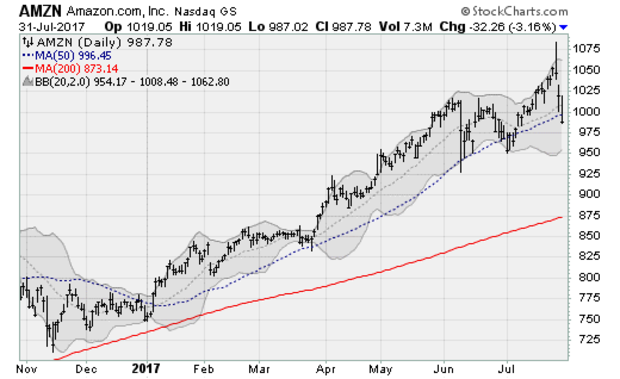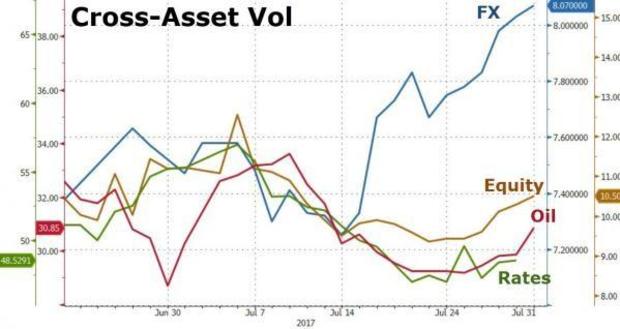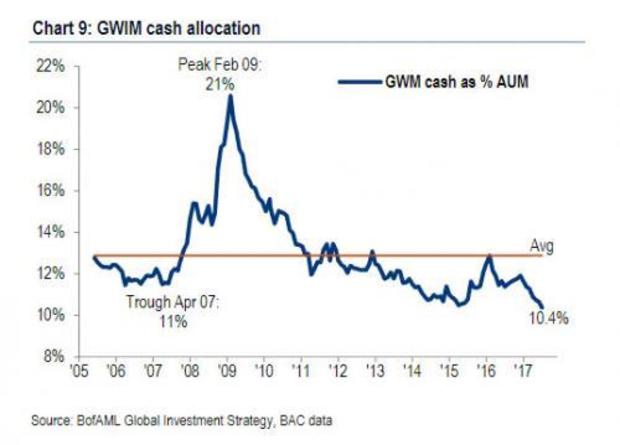Wall Street's smooth sailing enters choppy waters
U.S. equities mostly finished lower on Monday as volatility continues to increase, led by deepening weakness in big-cap tech stocks. Known as the "FAANGs" -- for Facebook (FB), Amazon (AMZN), Apple (AAPL), Netflix (NFLX) and Google (GOOGL) -- these stocks captivated investors in recent months for their seemingly relentless upward momentum.
Yet after some disappointing results and guidance from Amazon and Alphabet (Google's parent) last week, profit-taking pushed selling higher. Amazon closed below the $1,000-a-share level on Monday, down 3.1 percent, and fell below its 50-day moving average for the first time since the beginning of July (chart below). Looking at downside volume, that's the most serious pullback for the e-commerce giant since November.
Looking in the rearview, the action over the last few sessions feels like a definitive break from recent trends -- which are looking increasingly unsustainable.
Nasdaq gained 3.5 percent in July for its best month since February. And it has risen in 11 of the last 13 months. Big tech stocks jumped 10 percent overall for their best month since October 2015.
The Dow Jones industrials index has climbed in eight of the last nine months, with the down month a loss of less than 1 percent, for the best run since April 1983.
And the CBOE Volatility Index recently hit a record low, with the market logging more than a year without a 5 percent pullback.
But cracks are appearing in the veneer that suggest this historic lack of downside moves could be coming to an end.
The Dow Transports fell 3.5 percent in July for the worst month since Brexit in June 2016 on concerns about weak economic data. The U.S. dollar continues to careen lower, hitting levels last seen in 2014. July was its worst month since January and the greenback's longest losing streak since 2011.
Keep an eye on the dollar, as rising currency market volatility is poised to spill over into other asset classes (chart above) amid a historic lack of downside movement in the stock market. Fueling the dollar's decline is the political gridlock in Washington as well as ongoing disappointment with U.S. economic data.
Also remember that sentiment is red hot and investor positions are at extremes, with cash levels ultra-low, according to Bank of America Merrill Lynch (chart below). Schwab's management recently warned that clients are opening brokerage accounts at a pace not seen since 2000 as millennials pile into an overvalued market.
Jason Goepfert at SentimenTrader points at the very narrow rally by the Dow Jones industrials to new record highs over the last 30 days. The index even set a new high on Monday as the rest of the market drifted lower. This combination has triggered eight "Hindenburg Omen" signals over the past 30 days. That's ominous name for a technical signal triggered by an increase in the number of stocks hitting new lows even as the major averages keep hitting new highs.
Goepfert warns that "Despite the silly name, the signal is a serious reflection on the internal performance of stocks within an index." And this is the largest cluster of Omens since October 2000. Over the past six months, the S&P 500 has seen nine Omens -- the most since 2007.
Other oddities abound in this environment. The Dow scored its third record close in a row on Monday, yet the S&P 500 index fell each day. That has only happened one other time since 1928: On April 15, 1999, after which stocks suffered choppy trading.
According to BlackRock research, history suggests that even if stocks suffer a bout of weakness here, the low volatility regime that has been in place for the last few years should return as long as GDP growth remains more or less stable. While growth has been rather tepid, it has been relatively consistent.
Of course, that could be undermined by the Federal Reserve's plans to unleash "quantitative tightening" and another quarter-point interest rate hike later this year. Perhaps along with good old-fashioned earnings disappointment, this is what's motivating the sell-off in the tech stocks. And if economic growth looked so good, why is the dollar tanking?







